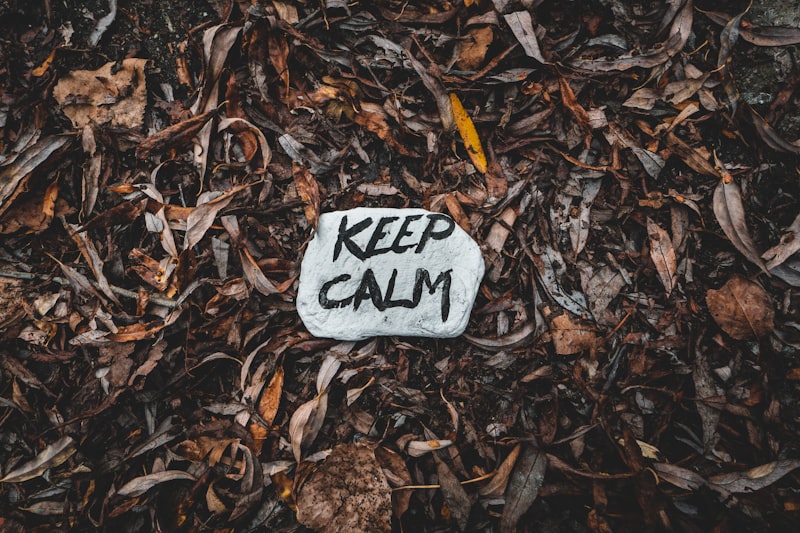Feeling overwhelmed by stress and anxiety? Yoga might just be the calming practice you need to find your center again. This ancient discipline not only tones your body but also soothes your mind, making it a powerful tool for managing modern-day pressures.
Yoga works wonders by combining deep breathing, meditation, and gentle movements. When you practice yoga, you engage in a series of poses (asanas) that promote relaxation and mindfulness. The slow, deliberate movements coupled with focused breathing help to release tension stored in the body and calm the nervous system.
One of the most effective poses for stress relief is the Child’s Pose (Balasana). This resting pose gently stretches the lower back, hips, thighs, and ankles while promoting a sense of security and ease. It’s like giving yourself a comforting hug, allowing stress to melt away.
Another beneficial pose is the Corpse Pose (Savasana). Despite its name, Savasana is all about deep relaxation. By lying down with arms and legs spread comfortably, you focus on releasing tension from each part of your body. It’s a time to let go of worries and simply be present in the moment.
Moreover, yoga encourages mindfulness, a practice of paying attention to the present moment without judgment. This awareness helps break the cycle of anxious thoughts and fosters a sense of inner peace and tranquility.
Incorporating yoga into your daily routine doesn’t require much time or effort, but its benefits are profound. Whether you practice for 15 minutes or an hour, regular yoga sessions can significantly reduce stress levels and enhance your overall well-being. So, roll out your mat, take a deep breath, and embark on a journey to a calmer, more centered you.
Mastering Serenity: The Ultimate Guide to Using Yoga for Stress Relief
Yoga isn’t just about striking impressive poses. It’s a holistic practice that integrates breathing exercises, meditation, and physical postures to harmonize the body and mind. When you roll out your mat and begin your practice, you embark on a journey towards inner tranquility.
One of the core elements of yoga is its ability to reduce the physical effects of stress on the body. Through gentle stretches and controlled breathing, yoga helps release tension stored in muscles and encourages relaxation. Imagine each pose as a gentle massage for your body and mind, easing away the knots of stress accumulated throughout your day.
Beyond the physical, yoga is a powerful tool for mental and emotional well-being. As you flow through the poses, focusing on your breath and the present moment, you cultivate mindfulness. This mindfulness is key to managing stress, as it allows you to observe your thoughts without judgment and let go of unnecessary worries.
Incorporating yoga into your daily routine doesn’t have to be daunting. Start with simple poses like Child’s Pose or Cat-Cow Stretch to gently stretch your muscles and connect with your breath. As you become more comfortable, you can explore more advanced poses that challenge both your strength and flexibility.
Moreover, yoga can be practiced anywhere – whether in a studio, at home, or even outdoors. All you need is a quiet space and a willingness to let go of distractions. By dedicating just a few minutes each day to yoga, you can significantly reduce stress levels and increase your overall sense of well-being.
Yoga Unplugged: Effective Techniques to Calm Your Mind and Body
At its core, Yoga Unplugged is about simplicity and mindfulness. It encourages us to unplug from the noise of daily life—be it digital distractions or mental chatter—and tune into our inner rhythms. Through a series of gentle postures, deep breathing exercises, and meditation techniques, it guides us towards a state of deep relaxation and inner peace.
One of the key techniques in Yoga Unplugged is conscious breathing. By focusing on our breath, we anchor ourselves in the present moment. This simple act not only calms the mind but also relaxes the body, releasing tension and promoting a sense of well-being. It’s like taking a deep breath of fresh mountain air—it invigorates and clears the mind.
Another cornerstone of Yoga Unplugged is its emphasis on gentle movement. Unlike high-intensity workouts that leave you feeling drained, Yoga Unplugged invites you to move with awareness and grace. Each posture is designed to stretch and strengthen the body while cultivating a sense of mindfulness. It’s a bit like tending to a garden—each pose nurtures your body and soul, helping you grow stronger from the inside out.
Meditation is also a vital component of Yoga Unplugged. Through quiet reflection and guided mindfulness practices, it encourages us to let go of worries and embrace inner stillness. It’s akin to finding a quiet spot in a bustling city—it’s there all along, waiting for you to discover its serenity.
Breathe In, Stress Out: Yoga Poses That Combat Anxiety Instantly
Imagine this: you’re on the edge, deadlines looming, and your mind is racing. Instead of reaching for another cup of coffee or scrolling through endless social media feeds, why not try a few simple yoga poses that can work wonders?
First up, the Child’s Pose. This gentle stretch not only eases tension in your back and shoulders but also encourages deep breathing. As you kneel on the floor, folding forward with your arms stretched out in front of you and forehead resting on the ground, feel the stress melt away with each breath. It’s like hitting the reset button for your mind.
Next, let’s flow into the Cat-Cow Pose. This dynamic duo of poses is perfect for releasing tension in the spine and increasing flexibility. Start on your hands and knees, alternating between arching your back like a cat and dipping it like a cow. With each movement, synchronize your breath—inhaling deeply as you arch, and exhaling as you round your spine. Feel the soothing rhythm bring a sense of serenity to your day.
Now, if you’re looking to dial down the intensity, the Legs-Up-the-Wall Pose is your go-to. Simply lie down on your back with your legs extended up against a wall. This pose not only improves circulation but also calms the nervous system, helping to reduce anxiety and promote relaxation. It’s like giving yourself a hug from the inside out.

Last but not least, embrace the power of the Corpse Pose (Savasana). Often considered the ultimate relaxation pose, Savasana invites you to lie flat on your back, arms by your sides, and simply let go. Close your eyes, focus on your breath, and allow yourself to fully unwind. It’s not just a physical rest but a mental one too, leaving you refreshed and ready to tackle whatever comes your way.
Incorporating these yoga poses into your daily routine—even if it’s just for a few minutes—can make a world of difference in how you manage stress. So, the next time you feel tension creeping in, remember to breathe in and stress out with these yoga poses designed to bring instant relief.
Finding Peace in Every Pose: Yoga’s Role in Anxiety Management
Yoga, often perceived as a physical exercise regimen, transcends mere stretching and poses. It embodies a holistic approach to wellness, integrating breathing techniques, meditation, and mindful movement. Each pose, or asana, not only strengthens the body but also calms the mind. Imagine it as a journey where each posture unfolds like a story, bringing you closer to a state of ultimate harmony.
At the heart of yoga’s efficacy lies its ability to soothe anxiety through mindfulness. By focusing on the present moment, practitioners cultivate a deep sense of awareness, gently quieting the incessant chatter of worries and fears. It’s akin to finding a calm oasis in the midst of life’s turbulent waters.

Moreover, yoga encourages rhythmic breathing, which has been scientifically proven to lower stress levels. The deliberate, deep breaths practiced during yoga stimulate the parasympathetic nervous system, promoting relaxation and reducing the production of stress hormones like cortisol. It’s like a natural balm for a restless mind, offering solace in every inhale and exhale.
Beyond its physiological benefits, yoga fosters a sense of community and support. Many find solace in practicing alongside others who share similar struggles, creating a supportive environment where anxieties can be acknowledged and released. It’s a reminder that you’re not alone in your journey towards inner peace.
Yoga isn’t just about striking impressive poses; it’s about finding peace in every breath, every movement, and every moment. Whether you’re a seasoned yogi or a curious beginner, the practice offers a profound opportunity to manage anxiety and embrace a calmer, more balanced life. So, take a deep breath, roll out your mat, and embark on a journey towards tranquility—one pose at a time.
Mindfulness in Motion: Harnessing Yoga for Stress Reduction
Yoga isn’t just about striking a pose; it’s about mindfulness in motion. The beauty of yoga lies in its holistic approach—it combines physical postures, breathing exercises, and meditation to create a harmonious experience that nurtures both body and mind. When you roll out your mat and embark on a yoga session, you’re not just stretching your muscles; you’re also calming your mind and soothing your soul.
One of the key principles of yoga is mindfulness—a state of active attention to the present moment. As you move through different poses, you’re encouraged to focus on your breath and the sensations in your body. This mindfulness in motion helps you let go of worries about the future or regrets about the past, allowing you to fully immerse yourself in the present.
Imagine yourself flowing through a series of yoga postures, each one designed to release tension from a specific part of your body. With each inhale and exhale, you feel more grounded, more centered. Your mind clears, and suddenly, the stress that once seemed insurmountable starts to melt away.
Research has shown that practicing yoga can have profound effects on stress reduction. It lowers levels of cortisol, the stress hormone, and promotes the production of endorphins, which are natural mood lifters. This dual action not only helps you feel more relaxed in the moment but also cultivates a lasting sense of peace and resilience.
So, whether you’re a seasoned yogi or a curious beginner, consider harnessing the power of yoga for stress reduction. Roll out your mat, take a deep breath, and embark on a journey of mindfulness in motion. Your body and mind will thank you for it.
Frequently Asked Questions
What Precautions Should I Take When Using Yoga for Stress and Anxiety
Learn how to safely use yoga to manage stress and anxiety with these essential precautions. Follow proper techniques, start gradually, listen to your body, and seek guidance from qualified instructors. Ensure a suitable environment and consult a healthcare professional if you have any underlying health concerns.
How Often Should I Practice Yoga to Reduce Anxiety
Discover how often to practice yoga to reduce anxiety effectively. Get insights on optimal frequency for noticeable benefits and improved mental well-being.
Can Yoga Breathing Techniques Help with Stress Management
Discover how yoga breathing techniques can effectively manage stress. Learn practical methods to reduce stress levels through controlled breathing exercises, promoting relaxation and mental clarity.
What are the Best Yoga Poses for Stress Relief
Discover effective yoga poses tailored for stress relief with our concise guide. Learn how each pose targets tension and promotes relaxation, empowering you to integrate these practices into your wellness routine.
Is Yoga Suitable for Beginners Who Want to Reduce Stress
Yoga is highly suitable for beginners seeking stress reduction. Its gentle exercises, focused breathing, and relaxation techniques help alleviate stress effectively. Starting with beginner-friendly poses and gradually progressing ensures a safe and beneficial practice.


